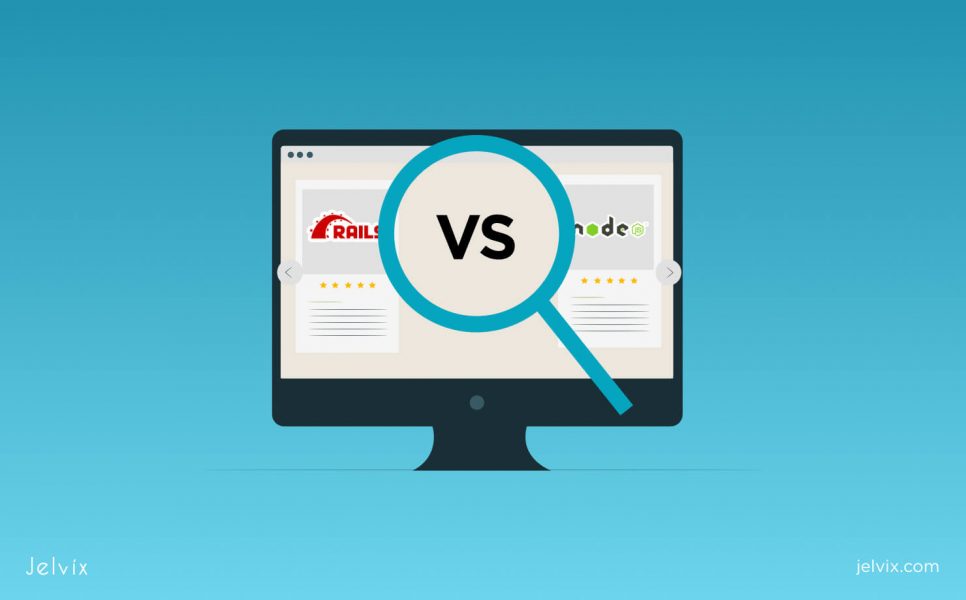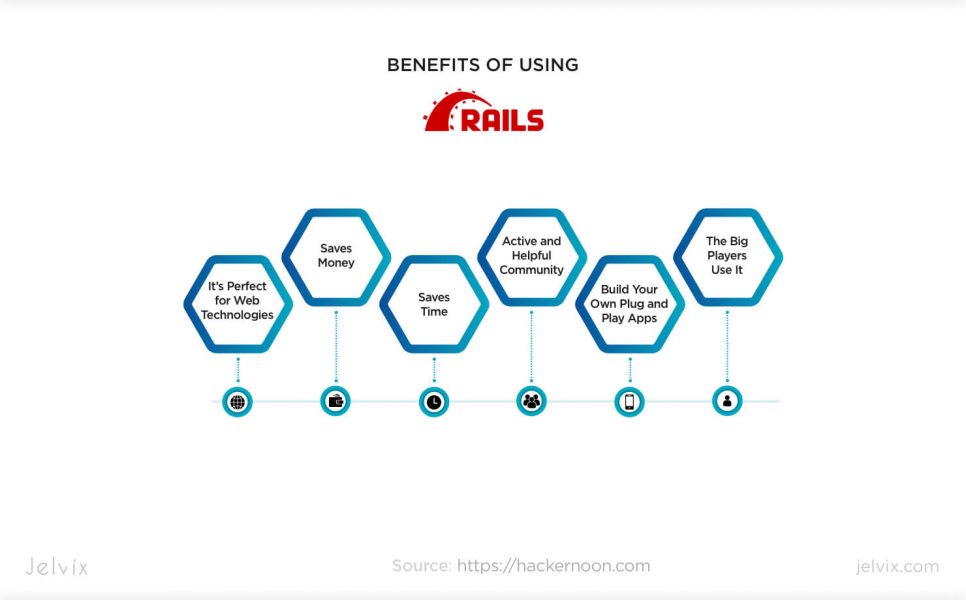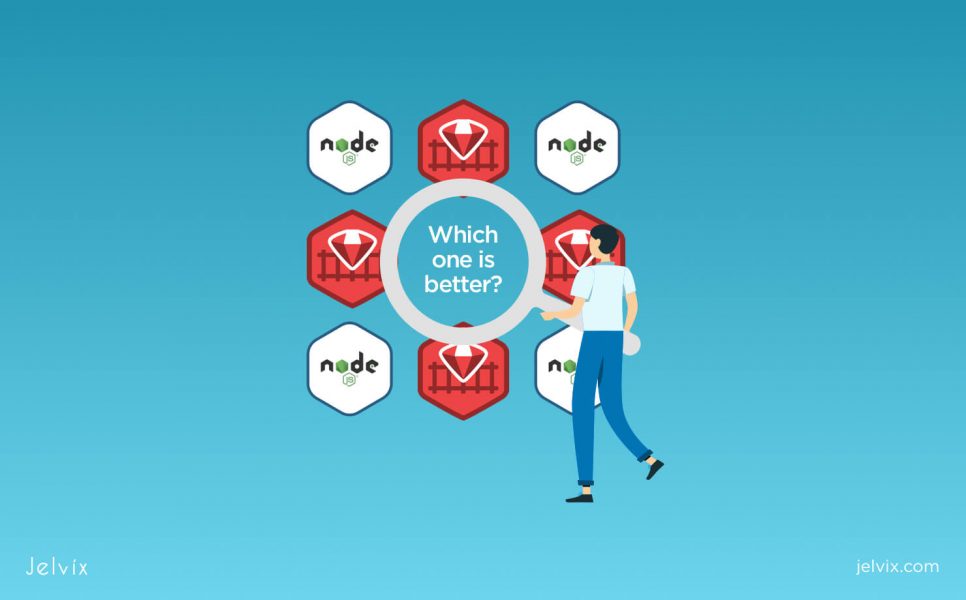Ruby On Rails has existed for more than a decade now. It is a framework of choice of Twitter, Airbnb, etc. And now many developers boldly claim that Ruby is dead and that everyone should stick to Node.js. That is, quite frankly, not much younger than RoR.
Also, it is not a framework. It is a web-server technology that is used with JavaScript frameworks, like Express, Meteor, Sails, and databases like MongoDB. However, such giants as LinkedIn, Hapi, and PayPal gradually decided to migrate from RoR to Node.js. If you’re interested in learning more about top Node.js frameworks, please check the best Node.js frameworks.
So why the Ruby on Rails vs. Node.js confrontation is one of the most popular topics in web development? Why, if at first sight, these technologies are so different? Why are they even compared? And which one is the best? Let’s try to figure this out.
Which one is the right solution: Ruby on Rails or Node.js?
First of all, let’s clarify that it’s not about which tool is better, and which one is worse. Both Ruby on Rails and Node.js are the most popular server-side technologies. And both of them have their pros and cons.
The thing is that each technology is better for specific purposes. And that’s precisely the goal we’re pursuing – to compare Node.js vs. RoR and understand when to choose which tool.
So, to figure out all the benefits and downsides, we’ve analyzed:
- the popularity of the technology over the past few years;
- scalability;
- what brands use the technology;
- how easy it is to adopt it;
- performance;
Having these criteria in mind, let’s begin our Ruby on Rails vs. Node.js 2020 comparison.
Ruby On Rails: an overview
Let’s begin with RoR because this technology came earlier. It’s a server-side framework written in Ruby, which is a multi-purpose and quite a dynamic language. When Ruby on Rails was released in 2005, it revolutionized the web development process offering a new approach.
It introduced a new software design paradigm that placed convention over configuration. Also, that eased the work for developers in many ways. For instance, now they didn’t have to work on the boilerplate code. Thus, developers could finally focus on the features and the logic of the future app rather than cumbersome coding.
Today Ruby on Rails is used by:
- GitHub
- Dribble
- Hulu
- Couchsurfing
- Basecamp
- Airbnb
And by over a half of million other websites. So even though the interest in this technology, comparing Ruby vs. Node, decreases, it is still quite popular and useful. If you go through job ads on Linkedin or Indeed, it’s evident that RoR developers are in very high demand. At Jelvix, we use this framework often enough to note all the pros and cons it has. So let’s begin with good things.
What are the pros?
One of the most prominent advantages of Ruby on Rails is that it is straightforward to learn. It is a well-known “schoolkids’ framework.” If you go on the Internet, you can find many success stories. People say that they just “woke up in the morning, decided to make their website/web app, then tried to learn RoR, and they got it right.”
That is why RoR is a frequent choice for freelancers. If you still don’t know what you need to do within this framework, you can be assisted by RoR developers community for sure. It is rather large and experienced because this technology has existed for so long.
However, as practice shows, you can solve this problem on your own. There are many branches with both typical and quite specific questions, which can arise during the Ruby on Rails usage. Whichever project you are considering, if it is built on RoR, it always has a standard structure and syntax.
Another reason to stick to Ruby on Rails is that it is an excellent choice for novice web developers. You can get a truly secure solution and not participate in the self-provision of its security mechanisms.
For example, RoR uses XSS filters by default. Also, there is a built-in authenticity_token tool that is used against CSRF attacks. It’s also great for preventing SQL injections and many other useful things. So when it comes to safety, in the battle Ruby on Rails vs. Node.js, the first fighter wins. If we talk about Node.js, you have to rely only on the security of the chosen framework.
Also, Ruby on Rails is great for developing on a tight budget and having a tight deadline. Since the community is so big, it doesn’t take long to find a good RoR developer. Moreover, only the lazy one does not know about the Ruby gems’ existence.
Ruby gems are free plugins, the code of which is placed on Github. The only disadvantage of gems is the inability to filter them according to their mission. Of course, you can figure out on your own which of them you should choose in a particular situation.
It’s good that the gem names kind of “speak for themselves.” However, the searching process can be quite c, so you can also check our article on Ruby gems.
Overall, it is quick and straightforward to build an app on Ruby on Rails. This technology is very mature, which means all the issues that could occur have already occurred and got fixed. Also, talented RoR developers know how to use all the advantages of this framework to save time and focus on the quality of the final product.
Check out the list of the most popular and useful Ruby Gems.
What are the cons?
Ruby on Rails won’t be an excellent fit for inexperienced specialists, especially if they want to build complex apps. Then this technology can bring many struggles in terms of maintenance, safety, and reliability of the application. RoR can be an excellent instrument for beginners if they are going to build blogs or simple APIs.
The fact that RoR is not the right tool for new devs is not the only disadvantage of this framework. It is slow, much slower than Node.js. However, this issue becomes visible only if you work with enormous projects with massive traffic. But if we’re talking not about a giant app with an endless number of users and requests, then Ruby on Rails might be not the real villain here.
The server architecture and databases also matter a lot. If the infrastructure is well-built, even large-scale products written on RoR can be rather swift. Take Airbnb of GitHub as an example – there are no issues with the performance.
The reason behind poorly executed RoR-based apps is that this framework does a lot instead of the developer. Thus, beginner devs usually make mistakes in creating code. That’s why we’ve said earlier that Ruby on Rails is not the best choice for fresh specialists. If the code is low-quality, the app performs poorly.
RoR doesn’t do well when it comes to scalability, either. This framework supports the dynamic AJAX interface. That’s something similar to the asynchronous code that also can be implemented in this way. However, it is not even close to being as flexible as Node.js. Even though we should not blame the framework for any issues with scalability, it is not easy to scale.
The perfect example is Twitter. Of course, taking this platform as a reference, we should consider the huge traffic it has. At some point, Twitter switched to Scala from Ruby on Rails. Perhaps, it was just the event that ignited the debates about the scalability struggle RoR brings.
Let’s list the scaling options Ruby on Rails has:
- horizontal scalability;
- code optimization;
- service-oriented architecture.
Last but not least, RoR is ancient. When new frameworks are born and bring innovations to development, they shine brightly. But when the excitement calms down, the previously fascinating technology becomes mundane and old. However, it doesn’t mean that Ruby on Rails becomes any worse.
You should think of maturity as of experience, stability, and refinement of the code. While it is interesting to chase the trends, old technologies are often quite able to compete with new ones. Since Ruby on Rails is still widely used, it means that this framework can survive the competition.
Node.js: overview
Node.js was released in 2009, which is not much later than RoR. The peak of the interest in this tool was reached in 2017. Even though this trend goes down, it is still way more popular when it comes to matching Node.js vs. Ruby on Rails.
Here are some of the companies that use this technology:
- eBay
- PayPal
- Walmart
- Uber
- Microsoft
- New York Times
Let’s remember once comparing Node.js vs. Ruby on Rails, that the first one is not a framework. It is a runtime environment that allows devs to build server-side apps with JavaScript. And even though many engineers make fun of JS and are skeptical about putting RoR and Node.js in the same line, we will be audacious enough to do that.
Based on our own experience at Jelvix, it would make sense to compare Node.js vs. RoR. Besides, we’ve already compared RoR with Python. While Ruby on Rails is a framework and, no doubt, has its strength, there are many situations where it falls back. Node.js, on the other hand, can offer the non-blocking I/O paradigm that is excellent for creating data-intensive and real-time apps. That’s something RoR can’t provide. So let’s jump straight to pros.
Is Node.js faster than Ruby on Rails?
Node.js is based on one of the fastest engines – Google’s V8. This and the ability to write high-speed asynchronous code are considered as truly killer-features. Matching Node.js vs. RoR, we can see that the first technology wins.
Yes, RoR supports the dynamic AJAX interface and allows devs to implement something similar to the asynchronous code. But unfortunately, even these features are not able to ensure the Node.js speed (the following diagram demonstrates this fact):
Furthermore, it’s said that Node.js shows the performance up to 20 times greater than the “old man” RoR. Thus, in the Node.js vs. Ruby performance battle, the first one takes the victory. So if you’re creating some streaming service like YouTube, stick to Node.js. Also, it is scalable enough to grow along with your app as it gets improved.
RoR has its Gems that we’ve discussed talking about this framework. And they’re frankly excellent. But with Node.js, web developers get much better capabilities. This web technology has an incredibly advanced tool – NPM. It’s a package manager that includes different modules that can solve hundreds of tasks – from the most trivial to the particular ones.
These modules are optimized so they could be easily integrated with third-party solutions. Thus, once you learn this tool, you get an ability to create only a skeleton and unique functions in all your web apps or websites. So other possibilities can be implemented using NPM in no time.
We positioned Node.js solely as a technology for creating web applications. Although it also can be used for both mobile and desktop development. With RoR, you don’t get such multi purposeness. Besides, Node.js provides easy-to-use and flexible tools for APIs creating.
From our experience, the trio of Express.js, MongoDB, and Node.js perfectly suits such purposes. Thus, the efforts you made to create the new application interface, in most cases, can have a positive result after just a few hours.
Comparing Node.js vs. Ruby, we can see that the second tool does not give you such flexibility. Moreover, RoR-based projects are much slower. In the end, this framework is not too good for creating software with complex business logic or interactive functionality. That’s why in this case matching Node.js vs. Ruby on Rails, we would pick the first option.
So what about adopting and learning Node.js? You should realize that it is not simple. So, when you decide to work with it and plan to learn only JavaScript, you can be disappointed. Moreover, a Node.js developer needs to master the work with JS frameworks and understand how to make queries in databases. On the other hand, this web technology is a great start to become a full-stack developer.
However, if you already know JS, learning Node.js is a walk in a park. And if you have some experience with C++ or Java, it can be even more comfortable for you.
What are the cons?
Now let’s talk about all the disadvantages we at Jelvix noted working with Node.js. First of all, this tool is exceptionally inconsistent. As far as its API is concerned, it changes continually, making this technology not quite stable to work with. Of course, it can get improved in the future. For now, we have to work with this inconvenience.
If you’re building a CPU intensive application, you should choose Ruby on Rails, because Node.js is not the solution here. It can result in significant performance issues if your application has to process images or render graphics. These processes need multiple CPUs. But because Node.js has a single-threaded processing mechanism, it can bring you to the enormous resource demand.
Finally, even though this technology exists for a decade now, in comparison with others, Node.js is still quite young. And while it catches up with the needs of the dev community quickly, many details require significant improvements. However, we think we don’t need to wait long for it. This tool is popular among developers because it is quite futuristic and rewarding.
So which one is better: Ruby on Rails or Node.js?
Let’s sum it up. Who won – Ruby on Rails or Node.js? Based on the feedback, Node.js is an incredibly progressive technology that is being constantly improved and updated.
For the basic knowledge of it, you need to learn only JavaScript. If you want to work with commercial projects, be ready to master much more material. But, the result is worth it because nowadays, this technology is often chosen for scalable project development.
Also, being experienced with Node.js means having the possibility to get a high-paying job. Today, the demand for Ruby on Rails specialists is much lower than for Node.js developers.
On the other hand, Ruby on Rails is an easy-to-learn framework. It is a perfect choice for small IT companies and suits both frontend and backend development.
To make it easier to perform a final comparison of Node.js vs. Ruby on Rails, we’ve created a detailed infographic:
Conclusion
As you can see, these technologies are somewhat equal. Therefore, we can make only one conclusion – your choice between Node.js and Ruby on Rails should be based on the goals and requirements of your project. Of course, the more experience you have with these tools, the better decision you can make.
So if you want to launch your own project, it is better to entrust its implementation to professionals. In particular, our guys are always ready for a new collaboration and will be happy to discuss the details of your website or web-based app. We are waiting for you!
Need a certain developer?
Access top talent pool to reach new business objectives.





















